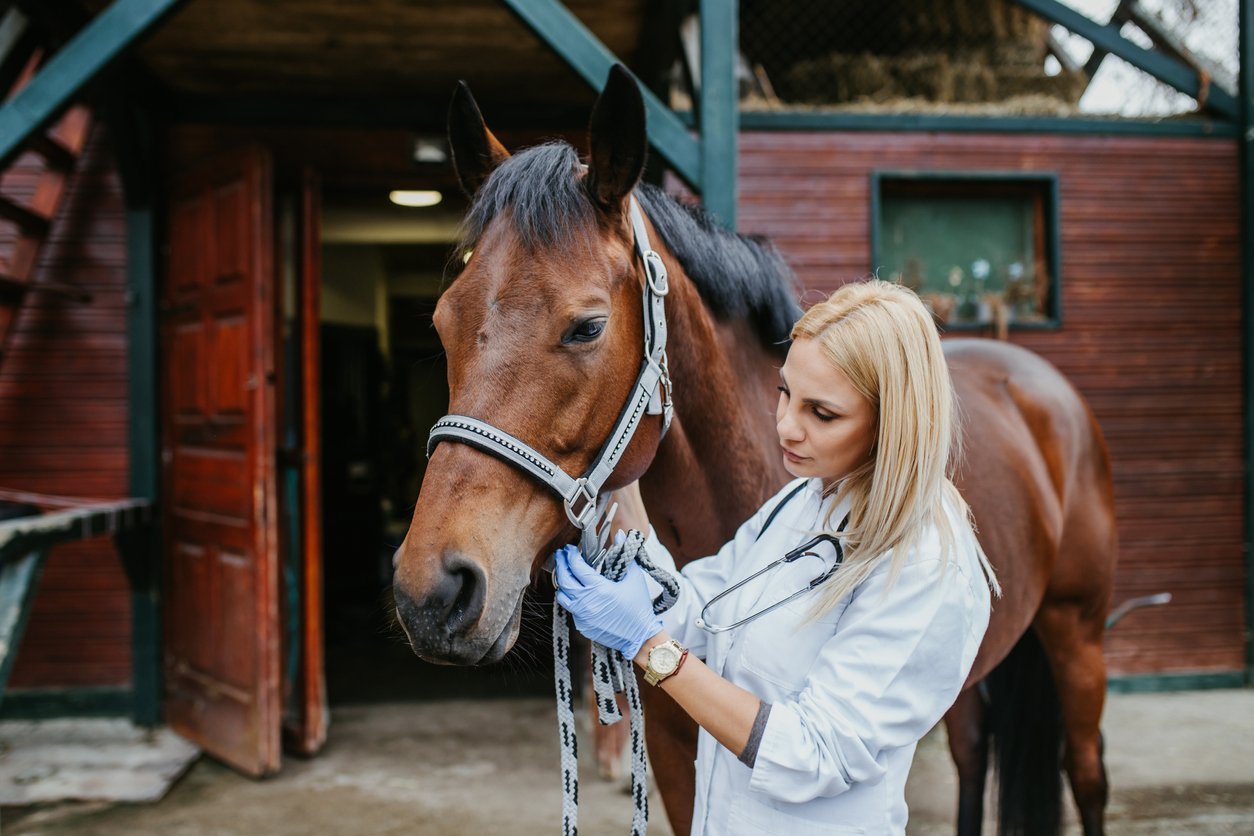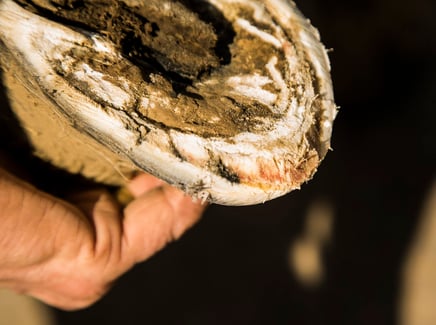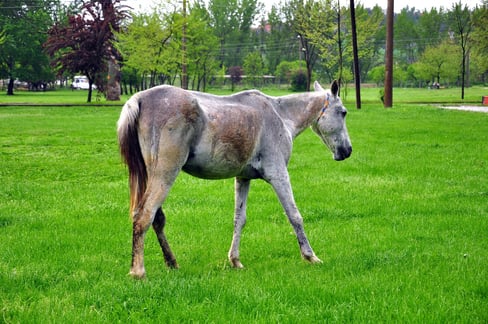Table of Contents
You may have heard of it: Cushings disease in horses.
And as a horse owner who’s always focused on well-being, it’s important to know the facts on this endocrine disorder. Thankfully, Cushings disease in horses is a fairly common condition, so there are plenty of management techniques. It can be difficult to diagnose, but early recognition leads to a vastly improved prognosis.
In this post, we’ll look at treatment for Cushings disease in horses, symptoms of Cushings disease in horses, and how it gets diagnosed in the first place.
Let’s have a look at this disease and what you can do about it.
What is Cushings Disease in Horses?
Cushings disease, also known as Pituitary Pars Intermedia Dysfunction or PPID, is a condition that causes hormonal imbalances in a horse. It is caused by abnormalities in the pituitary gland, which is a pecan-sized gland that sits at the base of the skull.
In a normal, healthy horse, the pituitary gland produces Adrenocorticotropic Hormone (ACTH), which controls cortisol levels in the body. Stress causes the adrenal glands (near the kidneys) to produce cortisol, responsible for helping the body use glucose (sugar) and fat as energy (metabolism). A tumour on the pituitary gland causes too much ACTH to be produced in horses with Cushings disease. As a result, cortisol continues to be produced. Overproduction of cortisol inhibits insulin from absorbing glucose in tissues and regulating blood sugar levels.
Cortisol also suppresses immune function which means that equines with Cushings disease in horses are more likely to get infections or other diseases than their healthy counterparts.
The diagram below shows the difference between a normal equine and one with Cushings disease in horses’ functioning in the hormone department. As you can see in a normal horse, they have a feedback loop that helps tell the pituitary gland to stop pumping out hormones. In an equine with Cushings disease in horses, it’s kind of like someone removed the “off” switch, causing your horse’s body to go into overdrive to produce unneeded hormones that have negative effects.
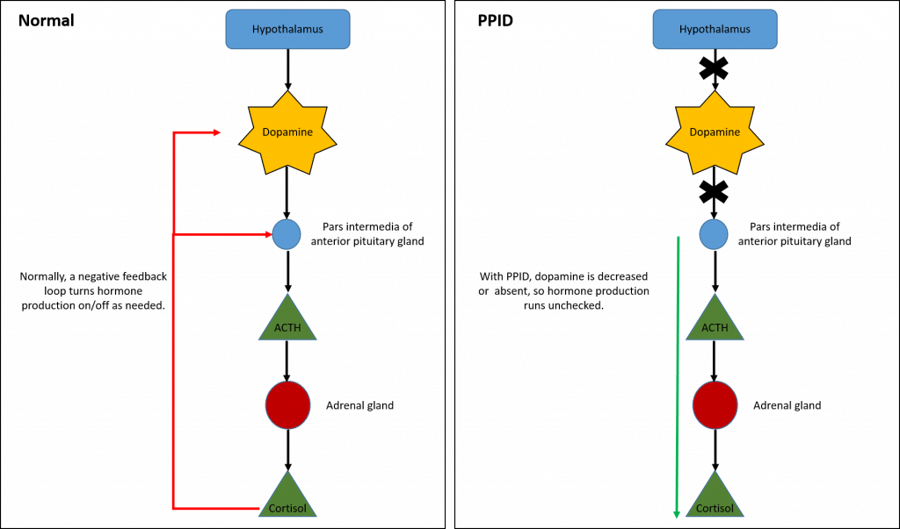
Breaking down the causes of PPID is pretty mysterious. It is difficult to pinpoint what causes the body to initially stop regulating the hormones produced by the middle lobe of the pituitary gland (known as the pars intermedia), but there are a few indicators and associations vets and researchers have noted we can look out for.
Cushings disease in horses can be associated with:
- Age (older animals are at greater risk)
- Corticosteroid use (bodies “forget” how to regulate normal levels of cortisol production)
- Laminitis (over 50% of horses with PPID have laminitis as well)
With that in mind, remember that you can’t 100% prevent the disease, and only monitoring early warning signs can help catch early-stage Cushings disease in horses so you can begin treating this disease.
Cushings Disease in Horses Symptoms
Making sure you understand the symptoms of Cushings disease in horses is hooves down the best way to keep your horse happy and healthy.
Since there is no screening tests or genetic testing available like there is for other kinds of horse health problems, you need to be vigilant and monitor your horse for changes in their normal behaviour and appearance.
Watch for the tell-tale symptoms of Cushings disease in horses:
- Excess, curly hair growth (hirsutism) on the neck, tail head, ears and lower legs that don’t shed normally
- Increased water consumption and urination
- Loss of muscle mass (particularly in the top line)
- Fatigue and listlessness
- Muscle weakness or stiffness
- Laminitis
On their own, each of these signs may not be obviously Cushings disease symptoms in horses, so if you notice even one thing out of the ordinary for your equine pal, give your vet a call to be safe.
Catching your equine when they are in early-stage Cushings disease in horses is the best way to prevent them from severe outcomes of this disease like death, particularly if infections and laminitis are avoided.
In order to determine if your horse has Cushings disease, your vet will need to perform a test or two.
The table below outlines the tests commonly used to detect Cushings disease in horses.
| Test for Cushings Disease in Horses | What It Is |
| Thyrotropin-Releasing Hormone (TRH) stimulation test | A test that measures a horse’s response to the injection of TRH as a way to check the function of the pituitary gland and its lobes. |
| Endogenous ACTH (adrenocorticotropic hormone) Testing | A test that checks for the natural presence of ACTH hormones in the horse’s body. The blood will have an increased ACTH concentration if Cushings disease is caused by excessive pituitary production of ACTH. When Cushings disease is caused by an adrenal tumour, or by cortisol-containing medications, there is less ACTH in the blood. |
| Overnight dexamethasone suppression test | The test collects a baseline cortisol sample, administers dexamethasone (a glucocorticoid), and collects one or more post-injection blood samples. Following the administration of dexamethasone, cortisol levels should drop between 15 and 19 hours after the treatment (hence being an overnight test). A horse with PPID will not experience a reduction in cortisol. |
| Magnetic resonance imaging (MRI) | Checks to see if there is pars intermedia enlargement or irregularities through an MRI. |
Cushings Disease in Horses Prevention
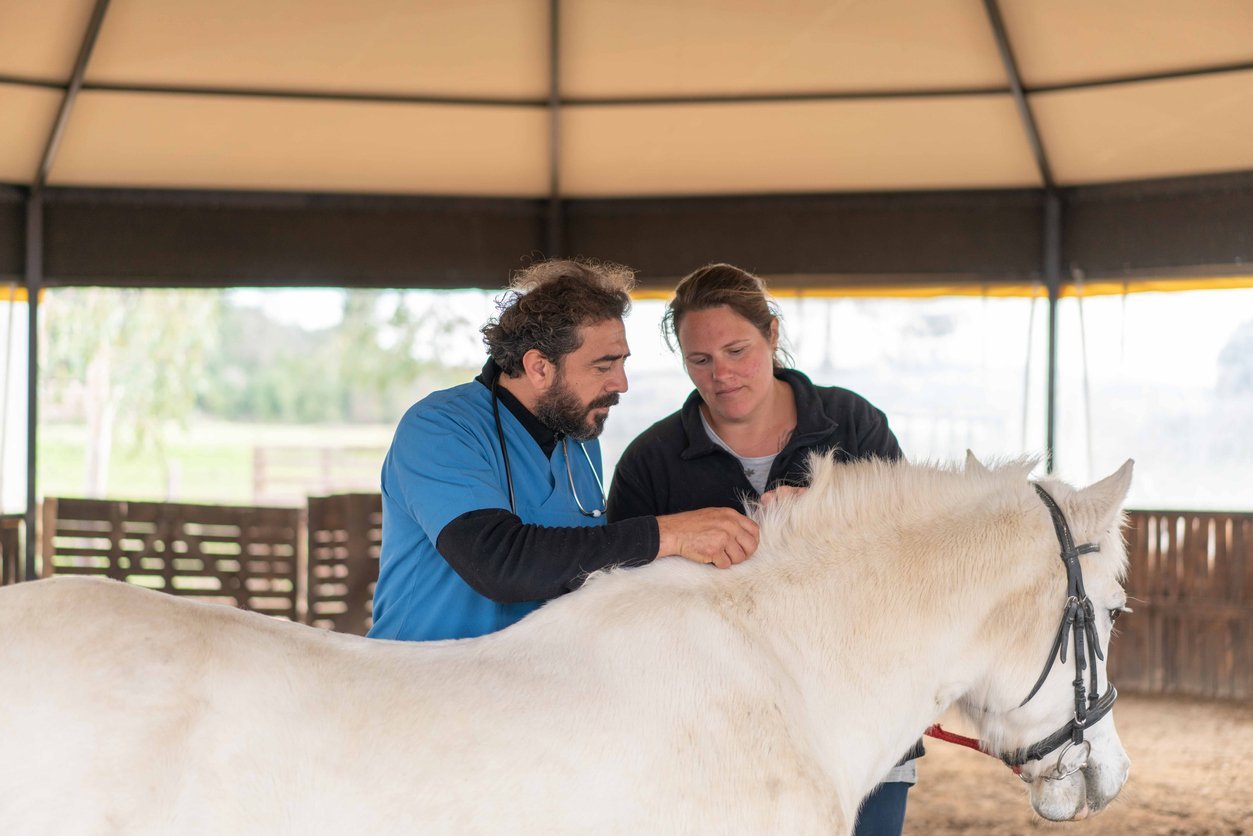
Cushings disease in horses is one condition that is incurable, and by extension, not preventable either. That is a hard truth to hear as a horse owner, but not to worry, there is good news!
Early detection, combined with effective management, and the avoidance of both laminitis and illness, can be your horse’s ticket to a longer, healthier, and more comfortable life.
And while there’s nothing you can do about preventing the condition, you can make sure you prevent the onset of serious symptoms and make sure Cushings disease in horses doesn’t affect your equine’s quality of life.
Frequent vet visits are the best way to prevent Cushings disease in horses. The diagram below shows how your vet can continually monitor for Cushings disease in horses, as well as how symptoms can change for untreated Cushings disease in horses over time.

As you can see, the only strongly suggestive early sign of Cushings disease is seeing select areas on the horse having unusually long hair, which continues to spread across the horse’s body as the disease progresses. This is why it can be hard to detect without the untrained eye of a veterinarian, as the other symptoms are fairly general.
Laminitis in horses is another comorbidity that is often found when there is Cushings disease in horses. In laminitis, one or both laminae (surfaces of the hoof) become inflamed. Cushings disease in horses is linked to this painful condition, which can lead to a lame horse, but we’re not exactly sure why yet. It is thought that it is related to the imbalance of hormones in a horse’s body that leads to the development of conditions like laminitis.
The bottom line is that your horse needs to be checked regularly by your vet to make sure they aren’t exhibiting any of the early-stage Cushings disease in horses signs to make sure you have the best chance at managing the disease.
Treatment for Cushings Disease in Horses
When it comes to treatment for Cushings disease in horses, it may seem daunting.
Why?
Because the first thing you’re going to see when you search “treatment for Cushings disease in horses” is that there is no cure. The management techniques that are used for Cushings disease in horses are intended to reduce symptoms. And in order to keep your horse comfortable, treatment must be continued throughout your horse’s life.
There’s good news though. Thanks to advances in veterinary medicine, and advances in testing techniques, we can now monitor for Cushings disease in horses better than ever. Plus, PPID is a common endocrine disorder for our equine pals, affecting about 20% of horses over the age of 15.
So let’s get into the management tips and techniques your vet will likely share with you if you’re dealing with Cushings disease in horses.
Cushings Disease in Horses Diet
First stop on the Cushings disease in horses treatment route?
Dietary changes.
Your horse with Cushings disease needs you to modify their diet in X primary ways in order to feel their best:
- Higher protein and calorie-dense foods
- Lower non-soluble carbohydrates
- Higher soluble carbohydrates
- Focus on foods with a low glycemic index (oils)
Cushings disease in horses leads to muscle mass loss and poor body condition in untreated cases. So, making sure your horse has enough calories and protein to maintain strong muscles and to keep weight on is crucial. Adding in a feed with extra calories for our underweight ponies can help make sure they don’t suffer from muscle wasting.
When you are adding those extra feed products to your horse’s diet, be sure they don’t contain high amounts of starch or sugar. This is detrimental to the management of Cushings disease in horses as these non-structural carbohydrates contribute to insulin resistance and high blood sugar problems Cushings causes. Instead, look for high-fibre (soluble carbohydrate) options like beet pulp to provide your horse with energy.
Additionally, some senior horse feeds may not be good for Cushings disease in horses since they may contain ingredients that cause a high glycemic response. That’s because they often contain a ton of non-structural carbohydrates and grains that have a high glycemic index. In fact, some senior horse feeds may contain the same glycemic index as straight oats! Oat no!
The bottom line? Feeding a Cushings disease in horses’ diet that helps reduce the stress on their bodies involves low starch, low sugar, and high fibre feeds, as well as the consideration of every feed’s glycemic index.
Supplements for Horses with Cushings
One of the key components of managing a horse with Cushings disease is modifying their diet, and with that comes introducing supplements. These can help support the deficiencies created by Cushings disease in horses.
The best types of supplements for horses with Cushings are outlined in the table below, along with how they help.
| Supplements for Horses With Cushings Disease | How it Helps |
| DHA and EPA | Reduces inflammation and helps improve insulin response |
| Vitamin E and C | Immune support and helps improve insulin response |
| Glucosamine for Horses | Helps support healthy hooves and joints |
| Magnesium | Improve levels of magnesium in the body typically low for horses with Cushings disease for better insulin regulation |
Just remember when you are picking a supplement for horses that it contains as little filler (preferably none) possible. Aside from having to feed more for any kind of therapeutic value, for Cushings disease in horses, these fillers can be sugary, starchy traitors to your careful dietary management.
Watch out for these common scratch and sugar fillers on the lists of supplements for Cushings disease in horses:
- Wheat and Rice Bran
- Dry yeast
- Soybean meal
- Maltodextrin (or dextrose)
- Dried Molasses
- Grains
A glucosamine chondroitin supplement for horses like TRI-ACTA for equine is 100% pure joint-health and soft tissue supporting ingredients. With no fillers to worry about, your horse gets to enjoy less inflammation and pain in their joints, and help maintain the health of their hooves and joints.
TRI-ACTA for Equine
Providing preventative support for younger horses and helping mitigate the early onset of joint degeneration and other mobility issues.
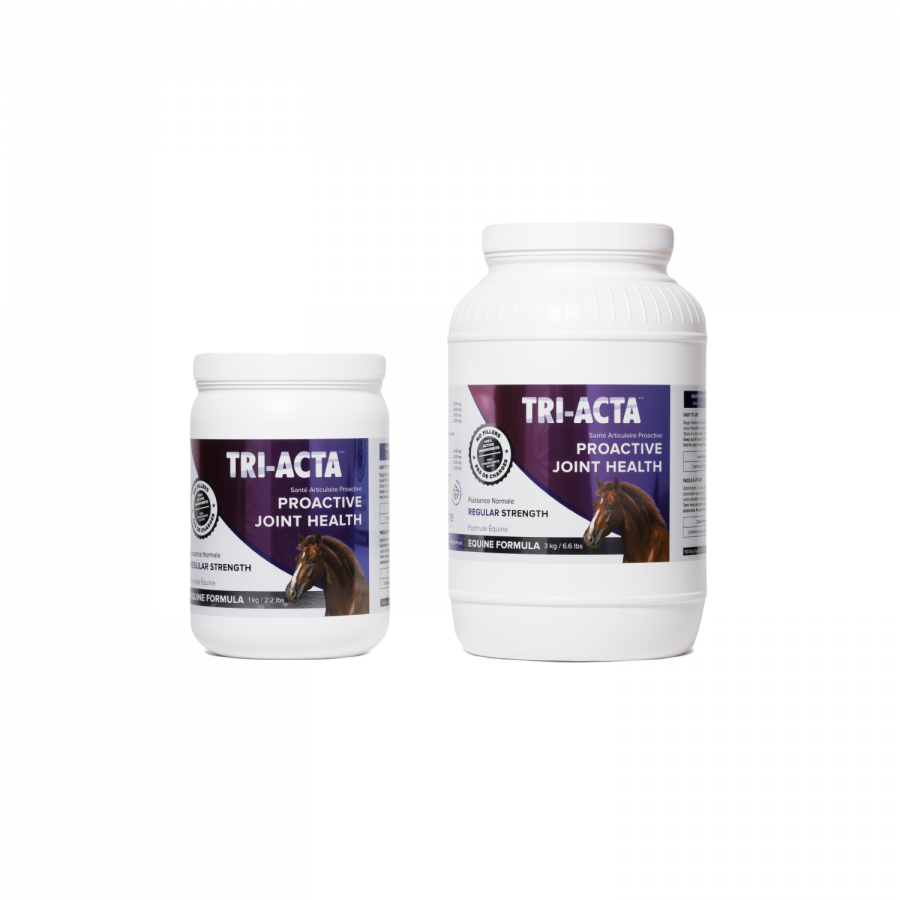
Daily Dose of Pergolide
If you’re looking for the most often recommended, most effective medication for treating Cushings disease in horses, then look no further than pergolide.
A daily dose of pergolide is able to suppress the irregularly functioning activity of the pars intermediary within the pituitary gland. This medication is taken orally and seems to help the horse within just a few hours of administration.
Interestingly enough, pergolide does not accumulate in the horse’s body and steady levels are realized within three days of starting the remedy. Additionally, with a half-life of fewer than 12 hours, pergolide leaves the body quickly, leading many to believe that the best way to feed it to your horse is once in the morning and once at night to take advantage of its benefits consistently.
That said, there are some drawbacks to using this drug.
Some common side effects of pergolide when used Cushings disease in horses treatment include:
- Loss of appetite
- Stomach and intestinal trouble, including colic
- Racing or irregular heart rate
- Agitation
- Muscle twitches
Always consult your vet if you notice any of the side effects listed above, or before ceasing a course of any kind of treatment for your horse.
Farrier and Vet Care
When you’re dealing with Cushings disease in horses, your horse needs extra care from their team of professionals to stay healthy.
And why is that, exactly?
Cushings disease in horses affects your horse’s immune system, making them more susceptible to infections, and conditions like laminitis and ringbone. Specifically, the condition affects immune cells called neutrophils used to neutralize infectious or inflammatory agents and assist the body in healing.
Neutrophils protect the body from infections by preventing, incapacitating, digesting, or warding off invading particles. Upon migrating to areas affected by infection or inflammation, neutrophils release toxins and enzymes to destroy bacteria. Their main task is to look for signs of infection and to kill the pathogens as quickly as possible.
That’s why it’s so important to ensure your horse is in good health, as they can’t fight the infection off the same way a normal horse could.
Your regular vet checks for Cushings disease in horses should include:
- A regular deworming and vaccination protocol
- Routine dental examination
- Periodic blood work
Additionally, regular farrier work is important, particularly if your horse has already had bouts of laminitis as a consequence of Cushings. A careful monitoring program and appropriate hoof care are important to maintain the comfort of these at-risk horses.
Horses with PPID should also receive good preventative veterinary care to ensure they are healthy due to a decrease in their immune responses.
Frequently Asked Questions on Cushings Disease in Horses
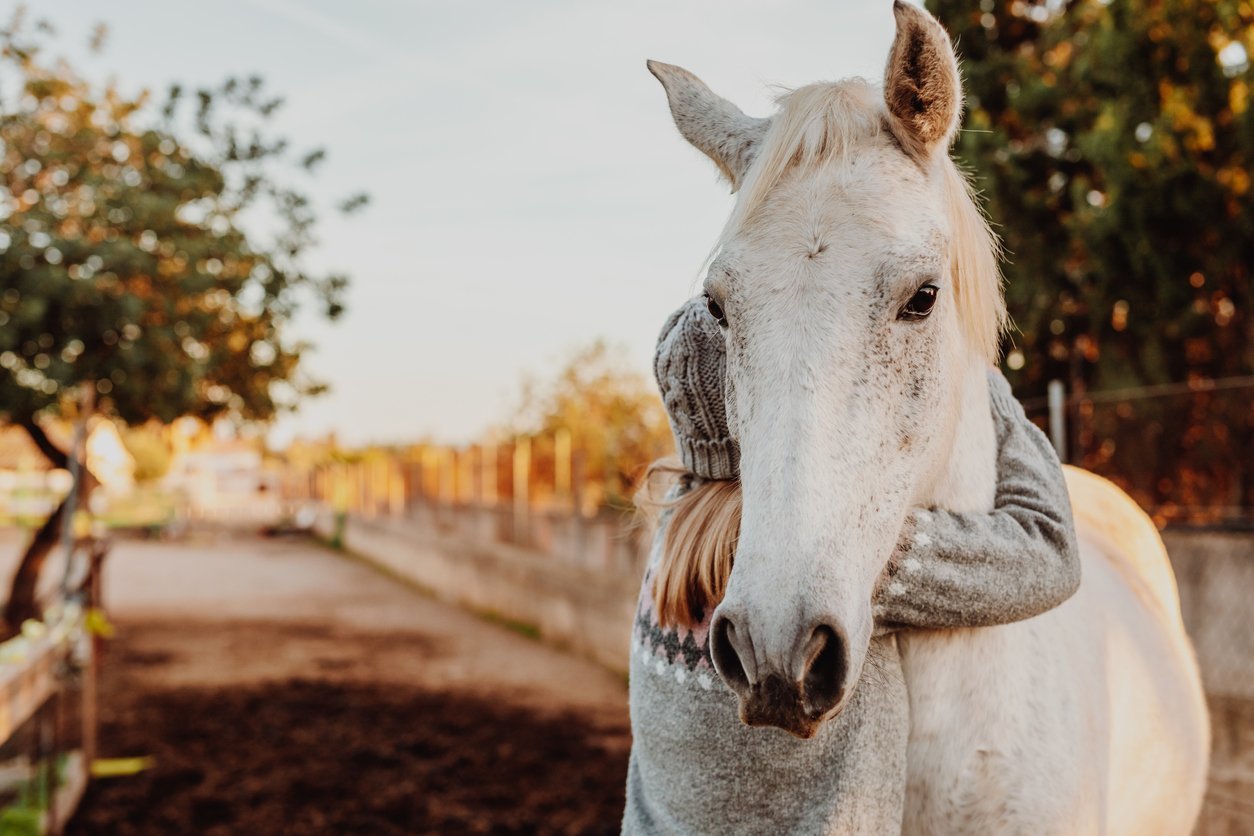
Let’s get into some of the most common questions about Cushings disease in horses, so you’re prepared to face this condition with your equine.
What Happens With Untreated Cushings Disease in Horses?
When Cushings disease in horses is left untreated it can lead to numerous health problems and even death for your horse. Your horse needs daily care to maintain good health, and avoid infections. Otherwise, your horse can develop painful conditions like laminitis, or worse, end up severely ill or dead.
What Is Cushings Disease in Horses’ Life Expectancy?
Horses with Cushings disease can still live long and healthy lives with careful management and attention from care professionals like your vet and farrier. Early detection and screening are also key to success.
Summary
Cushings disease is a very common endocrine problem in horses. It is caused by the overproduction of cortisol, a hormone produced by the adrenal gland. This condition can lead to severe weight gain, excessive thirst and urination, muscle weakness, poor hair coat quality, and even death if left untreated.
Horses with Cushings disease can also be susceptible to disease, so it’s important to focus on their overall health.
And what tool can you add to your toolkit to help support their overall health?
A supplement. Specifically a joint supplement like TRI-ACTA and TRI-ACTA H.A. for equine. When you choose TRI-ACTA, you choose 100% pure formulations with a small, easy-to-serve, yet therapeutic dose. And no matter what stage of life, or in their battle with Cushings disease in horses, Integricare’s TRI-ACTA can support the health of your horse’s soft tissues and hooves, as well as provide the benefits of glucosamine and chondroitin to your horse.
That way you can quit foaling around and help manage Cushings disease in horses.
TRI-ACTA H.A. for Equine
Our maximum strength formula is perfect for horses that are ageing, experiencing arthritis and stiffness, are in training and competition, or under a heavy workload.
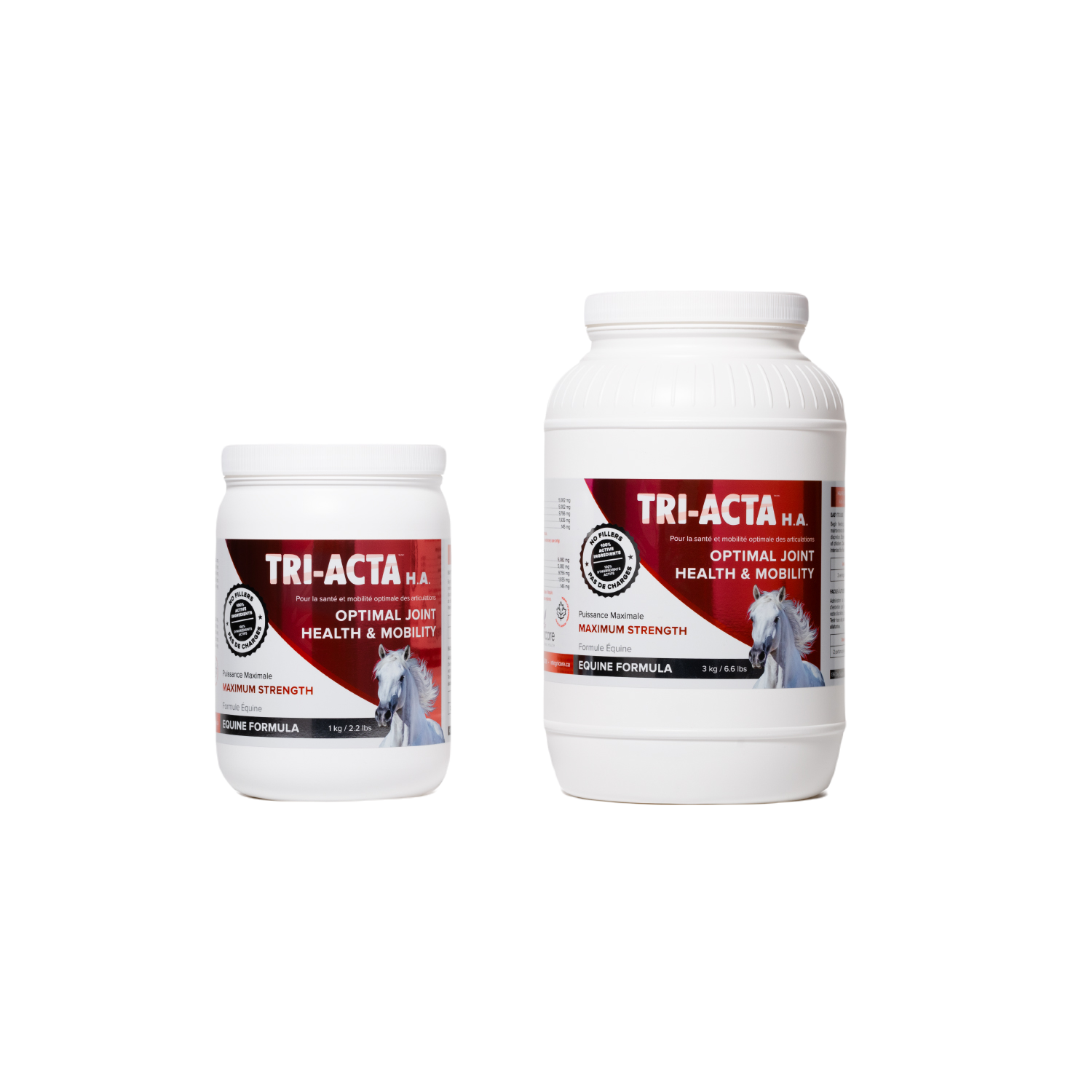
Newsletter Signup
Subscribe to our newsletter to receive the latest news and exclusive offers.
.jpg?height=2000&name=Cliick_Integricare-DISPLAY-REVISEDV2%20(1).jpg)
Proactive & Therapeutic Joint Supplements
When given daily, Integricare joint supplements recover bone and joint injuries faster and help prevent mobility injuries from happening in the first place.

